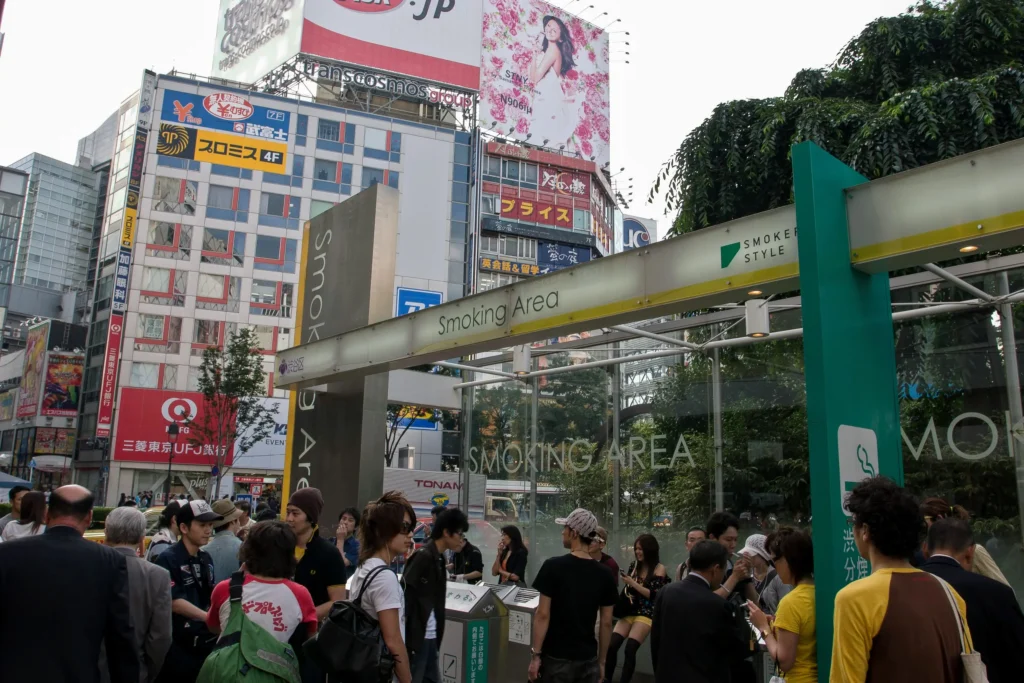We started our second day in Japan by exploring Ginza. First, we walked through Ginza to the Tourist Information Center to buy a tour for the next day and hear their suggestions for the day. Tourist Info did not sell any city tours; they suggested a place to go (downstairs in the same building). Tourist Info didn’t add much to the information we already had from Lonely Planet about what to see and do in Tokyo. It seemed that tourist info was good in helping to find a hotel.
An exciting place to step in was the Sony building. It had hands-on displays of Sony’s latest products, some yet to be released. We found the video camera section to be the most interesting. If somebody has in mind the idea of buying a video camera, this should be a place to try different options.
The weather was good, sun with small clouds and a temperature of about 25–26 degrees. It was perfect for walking. Although the distances between different areas of interest were quite large, we needed to take the subway to our next destination, Roppongi.
The subway (Japanese people call it the metro) is the most convenient way to get around the city (the subway map is a great help; you can get to any station). A single ticket costs 150 yen, and buying a subway ticket from a machine with coins is easy. Instructions in English are available. After entering the subway gates and slipping the ticket through the device, do not throw it away; you will need it when exiting the subway.
The subway train from Ginza to Roppongi Hills station took about 5 minutes. Roppongi Hills is a very modern area. The developer, Mori Minoru, envisioned it to be a microcosm of a city, centralizing homework and leisure. Here, in this shopping-dining-housing and entertainment center, we again found modern architecture, clean streets, and fashionable people.
We also visited Mori Tower. The entry fee of 1500 yen per person included the city view from a 270-meter-high open-air observatory and a modern art museum. The Turner Prize Retrospective exhibition was on display at the time in the museum. The view from the sky observatory was great; it gave a picture of Tokyo’s size. Twelve million people live in the city. It can be said that the land is very effectively used. The most significant green area to see was the Imperial Palace, with its gardens. Other houses do not have extensive gardens. The 360-degree view is worth a look at Mori Tower.
We had a sushi lunch in Roppongi Hills. The sushi bar was picked from the area map we got from the information center. A sushi lunch for two, including Miso soup and drinks, costs 4500 Yen. The sushi was fresh and delicious, although we did not see Taisha (the sushi chef) making the sushi.

After lunch, we took the subway to Shinjuku, a sprawling business, commercial, and entertainment center with a high concentration of skyscrapers. Every day, three million people pass through this station. Shinjuku subway station is the busiest in the world. The towers in Shinjuku are somewhat different from those in the Shiodome and Ginza areas. It seems that Shinjuku skyscrapers have a long history, and as there are also Metropolitan Government offices, the site is more conservative.
We visited the Tokyo Metropolitan Government Building Observatory, which is about 200 meters high. The entrance here is free, and it is said that on clear days, Mount Fuji can be seen. The day was not that clear, but the views were good. Although, after visiting Mori Tower, the observatory did not impress us so much.
We walked into the area to see Kabukicho – a famous red-light district. We followed the streets on the map (at least we thought so), but at some point, we realized we were not getting closer to the destination. We learned that the best help could be from police officers. There are plenty of them on the streets, and since the level of crime is shallow, they have time and will to help. So, finally, we found Kabukicho. The district was different from what we have seen so far. The hourly rates were on the billboards. We saw several massage salons, strip shows, love hotels, peep shows, etc. The freeters (street advertisers) mostly approach local men. Foreign men, especially those with female companions, are not their targets. So walking in Kabukicho is harmless but enjoyable as a different experience from Tokyo.
Although we had already seen a lot for the day, exciting experiences were still ahead. The day’s following (and last) stop was Akihabara, Tokyo’s discount electronics neighborhood. We visited two of the biggest electronics shops, Sofmap and Laox. Both duty-free shops have several floors full of well-priced electronics. In our opinion, Sofmap has a broader variety of goods. The prices are reasonable but not comparable to electronics in the United States.
After the shopping break, it was time for dinner. We asked the policeman where is the closest sushi bar. They suggested we go to Sushizanmai. This was a great place. As we already learned last night, the whole group of taishas welcomed us loudly. The sushi was just great, made under our eyes, and when we praised the sushi, a loud thank you in Japanese was heard. The dinner, including soup, drinks, and dessert, cost 3423 yen. This was the best sushi so far.
Related reading:
- Travel to the temple of Himeji, Kyoto
- Hiroshima, the island of Miyajima, Peace Memorial Park
- From Kyoto to Arashiyama. Visiting Kinkakuji Temple
- Nara, the historical capital of Japan; Northern Higashiyama
- Staying in a ryokan in Kyoto and visiting Gion Corner
- Day Three in Tokyo – Senso-Ji Temple and Odaiba
- How to spend three days in Tokyo?
- Tips and recommendations for traveling to Japan
- Ohara, a rural glimpse of Japan




